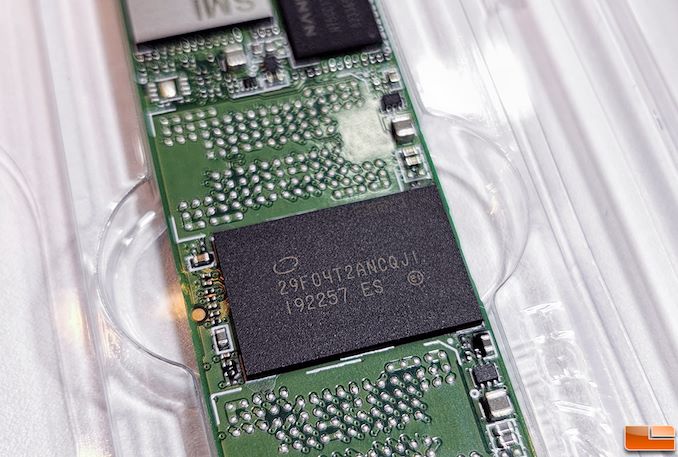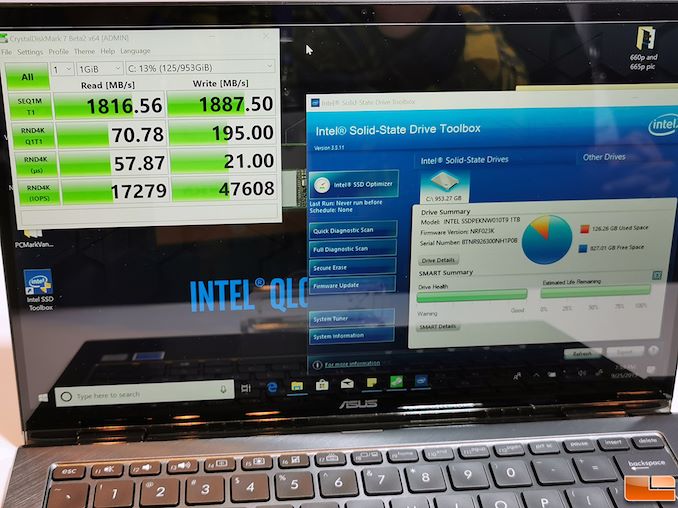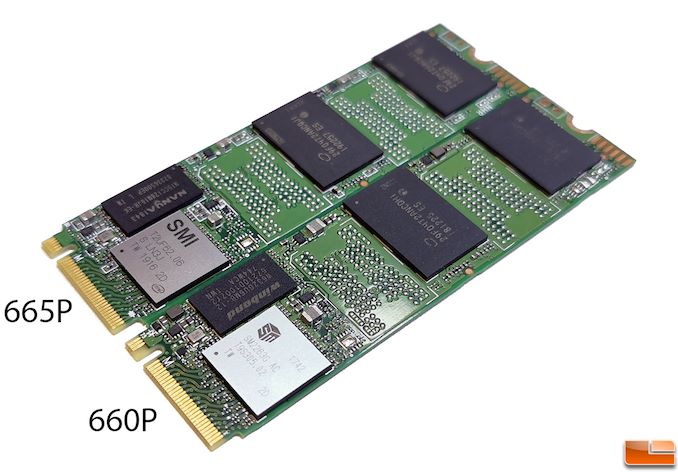Intel Announces SSD 665p: Denser, Faster QLC NAND
by Billy Tallis on September 26, 2019 12:30 AM EST
Intel's Memory and Storage Day event today in South Korea was mostly focused on enterprise and datacenter products, but they did announce an upcoming consumer SSD: The Intel SSD 665p. This is the successor to the Intel 660p, the first and most successful consumer SSD to use four bit per cell (QLC) NAND flash memory. The 665p isn't a major update: it keeps the same Silicon Motion SM2263 4-channel controller but updates the NAND to Intel's second-generation 96-layer 3D QLC NAND. This newer QLC keeps the same 1024Gb per-die capacity while shrinking overall die size, so we don't expect any change to the range of drive capacities offered nor any major performance changes—but it may lower prices a bit.
Intel showed off the 665p with a live demo pitting the 1TB 660p against a 1TB 665p prototype with pre-production firmware, each installed in otherwise identical ASUS notebooks. Intel used a beta version of CrystalDiskMark 7 to illustrate the 665p's performance: 40-50% improvement to sequential transfer speeds and about 30% faster random access speeds.
Left: 665p 1TB pre-production Right: 660p 1TB
(Photos by Nathan Kirsch of Legit Reviews)
Caveats: given the short test duration and relatively empty state of the drives, these numbers are measurements only of the SLC cache performance. It's not clear how much the worst-case write speeds to QLC have changed, and that's where the 660p falls far behind TLC based SSDs. The sequential IO numbers Intel showed for the 660p are also well below what we've measured with the 660p on our own testbed using CDM 7, so the sequential IO improvement might be more along the lines of 20% rather than 40-50%. Our testing of the Intel 660p also showed that it can reach similar speeds of 1.7-1.8GB/s in sequential transfers with a high enough queue depth, so the 665p's improvement here may amount to extending that performance down to queue depth 1. Either way, it looks like the 665p will be another drive that offers good enough performance for most use cases, but doesn't really need all four PCIe lanes.
Nathan Kirsch over at Legit Reviews has shared his close-up photos of the 665p alongside the 660p, so we know that the PCB layout is essentially unchanged: a single-sided M.2 2280 drive that only needs to populate all four NAND package locations for the 2TB model.
Intel hasn't shared the planned launch date for the 665p, but it should be no more than a few months away. Pricing should be comparable to the 660p, making it one of the cheapest consumer NVMe drives on the market.













26 Comments
View All Comments
Samus - Thursday, September 26, 2019 - link
I bet any performance improvement comes down to optimized firmware (which naturally the 660p won't get) as the changes to the NAND wouldn't realistically influence performance.Billy Tallis - Thursday, September 26, 2019 - link
A lot of 96L SSDs are getting a performance boost from faster interface speeds between the controller and the NAND. I'm not sure if that applies here, because the SM2263 is listed as supporting only up to 667MT/s and I think Intel's 64L QLC was already faster than that. It's mostly the Toshiba/SanDisk NAND that's seeing that kind of boost with the transition to 96L. There could still be some tweaks to the read/program/erase times with Intel's 96L, but you're probably right that the SSD firmware is likely responsible for most of the difference.sorten - Thursday, September 26, 2019 - link
I was wondering if Intel would stick with PCIE 3.0 considering their consumer chipsets are probably a year from supporting PCIE 4.0.Billy Tallis - Thursday, September 26, 2019 - link
In this case, they're sticking with PCIe 3.0 simply because their supplier for consumer SSD controllers isn't ready to start shipping PCIe 4.0 capable controllers. Intel's chipset roadmap is only indirectly involved.bzzt - Thursday, September 26, 2019 - link
Where are 4TB M.2 NVME SSDs?!haukionkannel - Thursday, September 26, 2019 - link
We need plc ssd for that... or smaller production node to fit more memory to the same space. Intel is Also talking abou 112 layer ssd memory. Mayby that allows cheap and unreliable 4tb m2 ssd to the market?MFinn3333 - Thursday, September 26, 2019 - link
They are right here.https://www.serversupply.com/products/part_search/...
MrCommunistGen - Thursday, September 26, 2019 - link
That's pretty neat and surprisingly good $/GB for a niche product... but just be aware that it is not the same size as most consumer M.2 drives.According to Samsung's product brief for the PM983 the drive is 30.5mm x 110mm (corresponding to 30110). Most M.2 SSDs are 2280 - meaning 22mm wide and 80mm long. Not all motherboards will have enough room around the M.2 slot to accept a 30mm wide card. Also, not all boards will accept a 110mm long card (ITX boards in particular tend to only accept up to 80mm M.2 cards).
MFinn3333 - Thursday, September 26, 2019 - link
Hey, the question was form factor type, not size...That said, good information. Intel has a 3TB M.2 for $2700.
Billy Tallis - Thursday, September 26, 2019 - link
You're probably looking at the specs for the version in the Samsung NGSFF/NF1 form factor, which is derived from M.2 but is definitely not M.2: https://www.anandtech.com/show/13609/pcisig-warns-...The M.2 version of the PM983 is a typical 22x110mm. Enterprise drives are usually 110mm long rather than 80mm because of the power loss protection capacitors or the need to fit more NAND packages on the card.